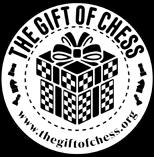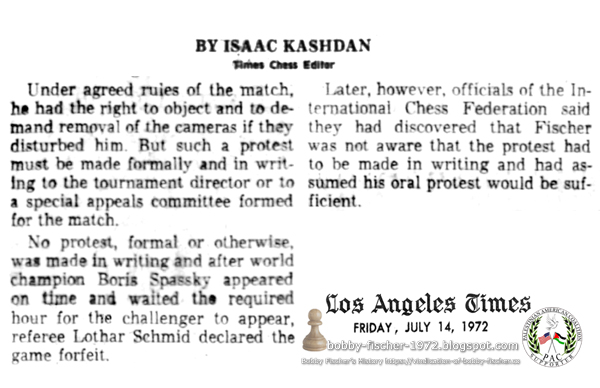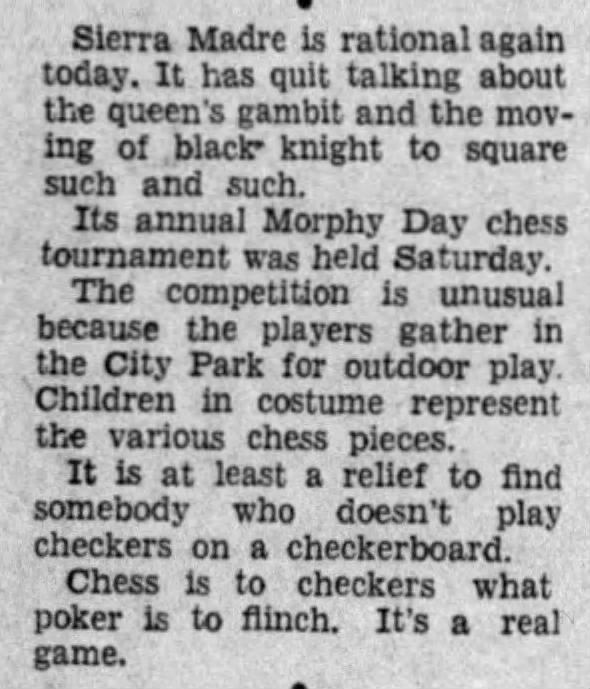< Prev Index Next >
Chess by George Koltanowski
First Game in Iceland
We abandon our regular series today to bring an account of the first game at Reykjavik, as reported by the UPI correspondents Milton Richman and Ian Westergren, along with the play of the first game Tuesday and Wednesday.
Word had filtered down that Fischer was “go, go, go” for that first match with Boris Spassky, Russia's world champion.
All the embroidery had been taken care of. The drapes, the TV cameras ([that is certainly untrue, as Col. Edmondson, who had a hand in drafting the agreement, reiterated, “Fischer had the right, however, to bar the cameras if he felt they were disturbing his concentration.” and Paul Marshall, the lawyer to Robert J. Fischer stated in regard to those crews of men operating cameras, “Bobby told me, ‘I can't think, it's a distraction.’”]), the lights, the chess board, all the things Fischer, ([and even the Icelandic officials and Soviet delegates themselves reportedly]) had kicked about.
Spassky was all set.
Everyone in the Reykjavik Chess Hall was holding his breath as the Russian, playing the white pieces, made the first move, opening with the Queen pawn.
The world championship officially was on.
But something was missing.
Fischer.
He wasn't there.
([And why was Fischer late? After all, with the promise of official Icelandic police protection, how could that possibly be? Well according to a report from the UPI on July 12, 1972, “The first game started with Fischer being late eight minutes because he had been delayed by traffic.” Yeah, something like that. It was the responsibility of police to verify traffic conditions, but Iceland was more than content to fail in its duties and throwing up obstacles every opportunity.])
He [Fischer] wasn't there. He had an hour to make the first move. Fischer didn't set out to keep Spassky waiting. He didn't do it purposely. The officials clock was ticking but he … ([was unfairly delayed due to failure of police to clear traffic as they were under obligation to do, but Icelandic officials, “didn't care” about keeping their word to the Americans]).
([Snipping a lot of regurgitated rehash of Soviet propaganda which has recently flooded into American media from behind the pleats of the Iron Curtain. The motive behind the selection of the ultra-racist Iceland as the Soviet prime pick to host this venue, besides the glaring lack of modern satellite communications in Moscow's hope to bury coverage was that Iceland has a notoriously hostile in its Anti-American atmosphere, presumably the perfect choice to effectively implement the Soviet's brazen effort to break the morale of the American team and knock the challenger's wind out of him, before the match has a chance to begin.])
Finally, after eight minutes, during which time Spassky got up impatiently and walked around, Fischer appeared.
He shook hands with Spassky and then sat down in his special swivel chair which he had flown in from New York for these championships.
Fischer studied the board two minutes, then made his first move, knight to King bishop three.
In his own mind, Fischer feels he's one little guy taking on the whole Russian government. He doesn't feel this way because of any politics, the usual politics between countries, that is, but because of chess politics.
Regardless, he always plays to win.
Tuesday's first game was adjourned, meaning each man had made his allotted 40 moves in the five-hour time limit with no decision being reached.
Conservative Play
In this first of 24 games, Spassky played the way everybody thought he would—conservatively. That figured because if this whole business winds up even, say 12-12, Spassky goes back to Russia the same way he came to Reykjavik — world champion.
Spassky asked for adjournment after 40 moves and 4 ½ hours play.
When the two resumed the game at 5 p.m. Wednesday — the first in their $250,000, 24-game world match — Spassky has a bishop and three pawns against Fischer's five pawns.
But nobody came up with an explanation why the American chess genius went straight into what appeared to be a Russian trap. ([Actually, that is patently false. Robert Fischer proposed the obvious, that some officials in the Chess World seem to be conspiring together in neatly brushing under the rug. As Col. Edmondson, who had a hand in drafting the agreement, reiterated, “Fischer had the right to bar the cameras if he felt they were disturbing his concentration.” and Paul Marshall, the lawyer to Robert J. Fischer stated in regard to those crews of men, some in crews up to three men, located no farther than 15 feet away, in full view of Mr. Fischer, operating cameras, “Bobby told me, ‘I can't think, it's a distraction.’” and Harry Golombek reports, on July 13, 1972, “…a dramatic suspension of play. Fischer observed that a cameraman was training a camera on him from the roof. He protested and said he would not resume play until the camera was removed. For 32 minutes the game stood in abeyance, and in the interim. Fischer's clock was going. However, he had plenty of time. Fred Kramer, vice-president of the American Zone of the World Chess Federation, called in the police and the cameraman was ordered away.” while Schonberg on July 13, 1972 clearly presumes the culprit is yet another disruptive camera crew, located in a different are of the sports arena, “…Fischer objected to a television crew working from an aperture at the side of the stage. He said that the movements of one of the cameramen distracted him, and he stalked off the stage. Fischer's clock was on during his absence and when he finally returned to the chess board, he was left with 25 minutes to make 16 moves. Officials of the Icelandic Chess Federation and members of the Fischer delegation rushed backstage when Fischer made his objection, and pressure was brought on the cameramen to leave.” Fischer himself attests to perceiving himself swarmed with crews of camera men, stating for the record, “instead of..video tape film that didn't make any noise they just had guys with film cameras that were..all around.. making a racket. A nuisance. Too much noise, and visually you could see them moving around.” The excuse the Icelandic and Soviet officials gave, in refusal to comply with, and brazenly break the rules, according to an AP report on July 14, 1972: “Iceland promised that he would not know there was filming taking place, so he could concentrate. In two inspections prior to the match, he was not shown the television equipment.” And in spite of the reported July 14, 1972 report by Harold Schonberg, that “At 11:58 P.M., two minutes before the deadline for filing a protest, Fischer's aide, Fred Cramer, handed a formal written protest to Schmid. Cramer said Fischer had not seen the note.” So a formal written protest was indeed submitted, and before the deadline expired, but according to Isaac Kashdan, who was under the wrong impression that, “Under agreed rules of the match, he ([Fischer]) had the right to object and to demand removal of the cameras if they disturbed him. But such a protest must be made formally and in writing to the tournament director or to a special appeals committee formed for the match. No protest, formal or otherwise was made in writing and after world champion Boris Spassky appeared on time and waited the required hour for the challenger to appear, referee Lothar Schmid declared the game forfeit. Later, however, officials of the International Chess Federation said they had discovered that Fischer was not aware that the protest had to be made in writing and had assumed his oral protest would be sufficient.” Yet, it is in fact documented above, by NY Times, Harold Schonberg, that Fred Cramer submitted the written formal request by 11:58 P.M. “two minutes before the deadline expired,” so the formal protest was filed within the deadline. But Soviet and Icelandic officials chose to simply disregard and bend the rules in favor of the Soviet Union, and awarded Spassky the forfeiture point, anyway.])
“He took a chance to win a chance,” said Danish grandmaster Jens Enevoldsen ([who once again, attempts to obfuscate the real matter of several disruptive crews of camera men, operating in full view of Fischer, put there to blow Fischer's concentration and throw points in favor of the Soviet delegation.])
“We will never know until Fischer tells us—if he does,” said another international grandmaster. ([A Soviet no doubt, and there's no need to drag Fischer up from the grave when the blunt answer was already provided above from contemporaries]).
Fischer obviously was displeased with his game. ([Naturally, because of Soviet cheating.]) After the adjournment he angrily demanded a meeting with the Icelandic organizers to complain against what he described as the noisy audience ([oh please! We know already that such Soviet obfuscations were alleged no doubt. Yes, yes, “perhaps it was due to the drapes or the size of the chess pieces” to cover up the fact Fischer's complaints were directed against the rule-bending crews of camera men, strategically encircling Fischer, and forced upon Fischer in a calculated effort to blow his concentration. Again, see contemporary reports, above.]) Some 3000 Icelanders and foreign chess enthusiasts has packed into the Lagardur Hall for the opening thriller. But most knowledgeable observers said they felt the audience was more quiet than is normal at top chess games. ([That's because Fischer's complaint was directed at disruptive camera crews, some in packs of three, 15 feet away from Fischer, making a lot of noise to disrupt Fischer and inhibiting the challenger from properly formulating his strategy.])
The Icelanders rejected Fischer's demand and told him it is up to the official referee, Lothar Schmid of West Germany, to run the game from now on.
Fischer interrupted the second day's play by walking off the stage in irritation after the first three moves, then returned to resign on the 56th move.
 Chess 14 Jul 1972, Fri The Signal (Santa Clarita, California) Newspapers.com
Chess 14 Jul 1972, Fri The Signal (Santa Clarita, California) Newspapers.com
Yes… yes, the reports confirm the Soviet/Icelandic officials and delegates CHEATED. Cramer delivered the formal “protest” as required, in writing by 11:58 “two minutes before” the deadline expired. But the Soviets pretended it wasn't done by Fischer's team… simply ignored it, out of hand, to award Spassky the point.
“…The excuse the Icelandic and Soviet officials gave, in refusal to comply with, and brazenly break the rules, according to an AP report on July 14, 1972: “Iceland promised that he would not know there was filming taking place, so he could concentrate. In two inspections prior to the match, he was not shown the television equipment.”
And in spite of the reported July 14, 1972 report by Harold Schonberg, that “At 11:58 P.M., two minutes before the deadline for filing a protest, Fischer's aide, Fred Cramer, handed a formal written protest to Schmid. Cramer said Fischer had not seen the note.” So a formal written protest was indeed submitted, and before the deadline expired, but according to Isaac Kashdan, who was under the wrong impression that, “Under agreed rules of the match, he ([Fischer]) had the right to object and to demand removal of the cameras if they disturbed him. But such a protest must be made formally and in writing to the tournament director or to a special appeals committee formed for the match. No protest, formal or otherwise was made in writing and after world champion Boris Spassky appeared on time and waited the required hour for the challenger to appear, referee Lothar Schmid declared the game forfeit. Later, however, officials of the International Chess Federation said they had discovered that Fischer was not aware that the protest had to be made in writing and had assumed his oral protest would be sufficient.”
Yet, it is in fact documented above, by NY Times, Harold Schonberg, that Fred Cramer submitted the written formal request by 11:58 P.M. “two minutes before the deadline expired,” so the formal protest was filed within the deadline. But Soviet and Icelandic officials chose to simply disregard and bend the rules in favor of the Soviet Union, and awarded Spassky the forfeiture point, anyway.
How the Moscow snow, doth blow! Somebody had not informed GM Kashdan that the American delegation had indeed submitted a “formal written protest” two minutes before the deadline expired. Precisely 11:58 p.m. (See above). Therefore Fischer's protest was valid. The Soviets simply ignored it, and broke the rules, to award Spassky the point.
If justice had been done, and I have provided credible documented evidence, above from two experts in chess + PLUS Fischer's personal attorney, the official toll would declare “Fischer won the match 12½–7½, becoming the eleventh undisputed world champion”.









































